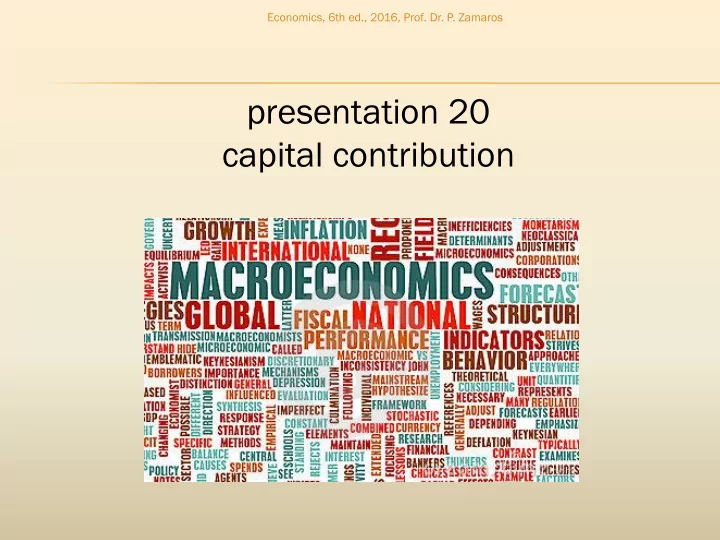

Economics, 6th ed., 2016, Prof. Dr. P. Zamaros presentation 20 capital contribution
Economics, 6th ed., 2016, Prof. Dr. P. Zamaros Capit pital Capital is formed through saving, which is the part of one’s income that has not been spent. Capital can be made available to borrowers in exchange for capital rent, that is, an interest (n) for the use of capital over a specified period (t). Since the interest rate is none else than the rate of return (for lenders) or the regular cost (for borrowers) on the use of a specified capital asset, any investment then is made according to its value and rate of return: lenders seek high rates, whereas borrowers low rates.
Economics, 6th ed., 2016, Prof. Dr. P. Zamaros Thus, whether lenders or borrowers it is the value of capital and the i- rate that are important along with two scenarios: Present Value (PV) : is the current worth of an asset; thus the issue is • finding or having the necessary funds to be spent today, an investment that is thereof discounted over a period of time e.g. mortgage scheme, credits, leasing, capital investments • Future Value (FV) : is the value of capital at a specific date in the future; thus the issue is about saving on a regular pace so as to raise the necessary capital in the future e.g. pension scheme, life insurance, replacing obsolete technology
Economics, 6th ed., 2016, Prof. Dr. P. Zamaros Both PV and FV are taken into account under capital formation
Economics, 6th ed., 2016, Prof. Dr. P. Zamaros Demand and supply ply Demand for capital is affected by the following factors: 1. Investment expenditure 2. State of the market 3. Size of rent 4. Maturity of the rent
Economics, 6th ed., 2016, Prof. Dr. P. Zamaros Supply for capital is determined by: 1. Future expectations 2. Consumption preference 3. Income levels 4. Social factors
Economics, 6th ed., 2016, Prof. Dr. P. Zamaros Capi pital cont ntribut ution on Economic growth through: • capital deepening and capital widening (exogenous growth) • improvements in productivity due to technological advancement and innovation (endogenous growth) However, the use of monetary and fiscal policies (discretionary and automatic stabilizers) must accompany the process.
Economics, 6th ed., 2016, Prof. Dr. P. Zamaros Exo xogeno genous us grow owth Capital deepening refers to the increased use of capital relative to labor K/L: the industries become more capital-intensive rather than labor intensive. This brings about a fall in labor factor costs (i.e. wages) – which will be resisted - and an increase in the expected rate or return relative to the capital employed (i.e. invested) from r1 to r2.
Economics, 6th ed., 2016, Prof. Dr. P. Zamaros Endogeno genous s grow owth Improvements in productivity bring about the increase of output when inputs remain unchanged.
Economics, 6th ed., 2016, Prof. Dr. P. Zamaros This implies an improvement in the utilization of K and L, thus an increasing ratio K/L, an increase in wages, and an increase in the expected rate of return r1 to r2. Overall, only when growth is endogenous is it acceptable for society because of the positive pay-offs for both investors and workers.
Economics, 6th ed., 2016, Prof. Dr. P. Zamaros Depreci eciation on Whether growth is exogenous or endogenous, one also needs to account for depreciation which shows what proportion of capital equipment K wears out. A production function S * f (K) growing away from K where the gap S * f (K) – K represents the excess investment needed for economic growth above depreciation:
Economics, 6th ed., 2016, Prof. Dr. P. Zamaros Depreciation is likely to reduce the expected return on investment; at the limit, the totality of the investment capital is used to replace obsolete capital. This, however, does not bring about economic growth because there is no increase in output. To solve this problem, the economy needs to render the same portion of capital used more productive through technological advance.
Economics, 6th ed., 2016, Prof. Dr. P. Zamaros e.g. US: with depreciation rising (increased additions to housing), capital formation (exogenous growth) is decreasing while R&D (endogenous growth) is fueling GDP
Economics, 6th ed., 2016, Prof. Dr. P. Zamaros e.g.CH although Switzerland does not have the highest investment level as a % of GDP (21%) it boasts for being the most competitive economy with very rich R&D sectors which can attract long-term investments More info: http://www.kpmg.com/CH/en/Library/Articles- Publications/Documents/Tax/pub-20120425-investment-in- switzerland-en.pdf
Recommend
More recommend